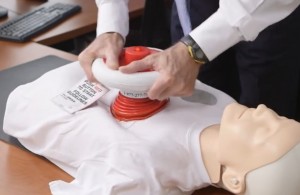 MILWAUKEE — More than two-thirds of Americans cite a lack of confidence in their life-saving skills as a reason they feel helpless to act during a cardiac emergency, according to the American Heart Association, even though immediate action is critical for survival. A new simple-to-use medical device takes the fear out of performing CPR, improving quality of chest compressions by 95 percent over manual methods.
MILWAUKEE — More than two-thirds of Americans cite a lack of confidence in their life-saving skills as a reason they feel helpless to act during a cardiac emergency, according to the American Heart Association, even though immediate action is critical for survival. A new simple-to-use medical device takes the fear out of performing CPR, improving quality of chest compressions by 95 percent over manual methods.
CPR RsQ Assist® is a handheld device that uses voice prompts to guide people through the life-saving process of hands-only CPR. Users can have confidence that chest compressions with CPR RsQ Assist® are being performed at the proper cadence and correct depth. AHA guidelines call for uninterrupted chest compressions; performing 100 compressions a minute for several minutes can quickly lead to fatigue.
“Statistics show that properly delivered CPR can double or even triple the rate of survival for sudden cardiac arrest,” said Joseph Hanson, inventor of CPR RsQ Assist®. “The reason CPR is so important is because it keeps a supply of blood moving from the heart to the brain. Permanent brain damage can occur in just a few minutes, and death is certain within 10 minutes.”
CPR RsQ Assist Inc., in conjunction with the Loren Marshall Foundation’s Big Wild Heart of Alaska initiative, is a sponsor of the 2015 Resuscitation and Critical Interventions (RACI) Conference, which will be held May 22-23 at the Hilton Anchorage, 500 W. Third Ave. The conference brings together renowned experts in the medical field to highlight current best practices in resuscitation based on emerging data in resuscitation science, including best practices for out-of-hospital cardiac arrest.
Sudden cardiac arrest is the leading cause of death in the U.S. According to a 2015 report by the American Heart Association, 326,200 people experienced out-of-hospital cardiac arrest in the U.S. in 2011.
“After a sudden cardiac arrest, survival to hospital discharge is only about 10 percent,” Hanson said. “With devices like CPR RsQ Assist®, we can improve survival rates. Literally anyone can save a life.”
